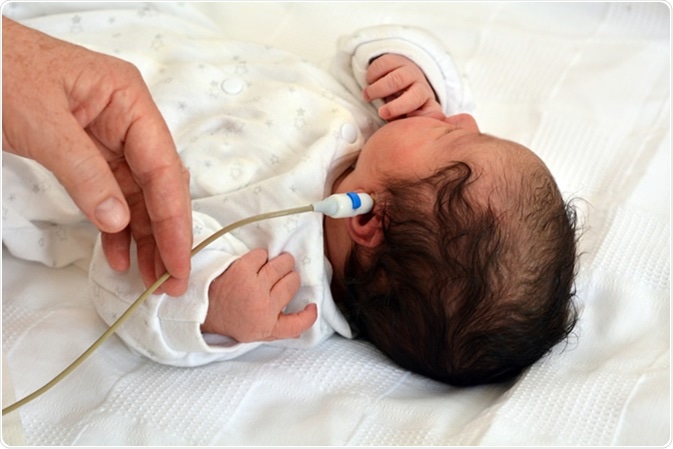Newborn children were not usually screened for hearing deficiency in the past. This was primarily because the technology to do so did not exist as yet. This resulted in lifelong problems with speech and language skills, usually translating to poor performance in school, buy zovirax online uk inability to interact well socially with peers and elders, and a number of emotional problems related to this issue.

Today there are many ways to test a newborn baby for possible hearing loss. This enables the doctors to educate the parents about what their child is likely to face. They will also be able to guide them about means and methods that the parents can employ to ensure that their child grows up facing less challenges.
What is EHDI?
Early Hearing Detection and Intervention (EHDI) is the process which allows for screening of babies from birth to toddler stage. The process helps to identify any baby who may have hearing loss and may need professional intervention. Ongoing care is set up for such babies so that the medical condition can be constantly monitored.
As per the EHDI norms, neonatal screening includes an audiological evaluation. This is to pick up the possibility of hearing loss in the infant. The screening is done by the age of three months. Should hearing loss be identified, further measures will be suggested. The parents are told to observe the psycho-educational development of the baby with particular attention to hearing, speech and language-related milestones.
How Screening Works for Hearing Loss in Newborns
Evidence-based systematic reviews have helped to reduce the age at which hearing loss is successfully identified in newborn babies. The first screening is done in the period of 30 days from birth of the baby. Should the screening show that hearing loss may be indicated, another screening of the baby is recommended before three months of age.
A physical examination is conducted to check for malformation of the auricle or ear canal. Other aspects that are checked include heterochromia of the irises, as well as dimpling or skin tags around the auricle. There may be cleft lip or palate, asymmetry or hypoplasia of the facial structures, and microcephaly, any of which may be indicative of an associated hearing loss disorder.
Waardenburg syndrome, Alport syndrome, cardiac problems and such may also cause hearing loss. Temporary hearing loss may be present in the infant, and this requires repeated follow-up to assess how the child is progressing through the developmental milestones. Parental concerns regarding hearing loss should be taken seriously by the medical care giver.
Dealing with Permanent Childhood Hearing Loss
Permanent Childhood Hearing Loss or PCHL involves permanent damage to the nerves, conductive tissue or middle ear. It may be due to a congenital defect, or a progressive disorder that develops in childhood. There may be instances of delayed onset of PCHL where symptoms of hearing loss show up later in childhood.
As per the CDC records of 2009, it was estimated that about 3 in 1000 infants are born with PCHL. 5 in 1000 parents of children in the age group of 3 to 17 felt that their child suffered from hearing loss, according to a study conducted in 2009 by Boulet, Boyle and Schieve.
The sooner this condition is diagnosed and appropriate intervention arranged, the more likely the child is to overcome the speech and language development problems. Depending on the actual cause the child may be given a hearing aid, or a cochlear implant.
Parental Support is Vital
While the child will be counseled by the healthcare provider regarding care and maintenance of the hearing aid, the parents need to be supportive of the child as well. For smaller children there may be issues with acoustic feedback, battery ingestion, and improper ear placement of the device. The primary caregiver needs to be alert to catch these problems.
As the child grows older and becomes more aware of the environment, the parent will need to work with the child to explain the importance of the correct usage of the hearing aid. The audiologist will have to be visited every 3 months in the first couple of years while the child uses a hearing aid. Follow-up and equipment checks are necessary even after the insertion of a cochlear implant.
The Social Stigma
Often there is some amount of stigma associated with using a hearing aid. The family will have to be supportive of the child to ensure that peer pressure does not take a toll. Psycho-social adjustment is very important if the child is to grow up to be a well-adjusted member of society. Just ensuring that the child can hear is not enough.
Parents will have to maintain a behavioral assessment record and ensure that the child undergoes regular speech perception testing. They will also have to consonantly encourage the use of devices in face of peer pressure. Coping strategies will have to be worked out for the child. Teachers and other caregivers will have to be educated about the child’s needs.
References
- http://www.asha.org/Practice-Portal/Clinical-Topics/Permanent-Childhood-Hearing-Loss/
- http://www.asha.org/Practice-Portal/Professional-Issues/Newborn-Hearing-Screening/
- http://www.asha.org/Topics/Expert-Panel-Recommendations-on-Newborn-Hearing-Screening/
- http://www.nhs.uk/Conditions/pregnancy-and-baby/Pages/newborn-hearing-test.aspx
- http://pediatrics.aappublications.org/content/124/4/1252
Further Reading
- All Hearing Loss Content
- Hearing loss – What is hearing loss?
- Types of hearing loss
- Causes of hearing loss
- Symptoms and diagnosis of hearing loss
Last Updated: Feb 26, 2019

Written by
Afsaneh Khetrapal
Afsaneh graduated from Warwick University with a First class honours degree in Biomedical science. During her time here her love for neuroscience and scientific journalism only grew and have now steered her into a career with the journal, Scientific Reports under Springer Nature. Of course, she isn’t always immersed in all things science and literary; her free time involves a lot of oil painting and beach-side walks too.
Source: Read Full Article
